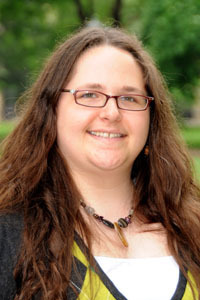The Genomics, Disease Ecology and Global Health Strategic Research Initiative Program and the Eck Institute for Global Health have awarded six graduate student fellowships in the areas of Genomics and Bioinformatics for the 2010-2011 academic year. These one-year awards allow graduate students in the College of Science and the College of Engineering to pursue graduate research programs that utilize the latest approaches in genomics and bioinformatics. This program also encourages collaboration between the two colleges as it relates to making available powerful state of the art tools in the fields of genomics and bioinformatics within the newly established Genomics and Bioinformatics Core Facilities.
The awards include:

Nick Geraci, Department of Biological Sciences, College of Science (Faculty Advisor: Mary Ann McDowell) - to study Leishmania major and L. donovani, two protozoan intracellular parasites that are the causative agents of cutaneous and visceral leishmaniasis respectively. These are highly morbid diseases of increasing concern in global health. The molecular mechanisms of differential cellular responses to Leishmania infections are not yet fully understood. The role of microRNAs (miRNA), short single stranded RNA sequences that serve as epigenetic regulators of gene expression in regulating cellular immune responses and ultimately pathogenesis will be the focus of research. The goal is to identify novel miRNA genes and miRNA targets to enhance our understanding of immunological regulatory pathways during infection.

Shawn O’Neil, Department of Computer Science and Engineering, College of Engineering (Faculty Advisor: Scott Emrich) - to develop methods and tools for analysis of population sourced genomic data. Given shotgun sequence data from a random sample of individuals in a population, can we computationally determine which reads belong together because they came from the same individual? How can we quantitatively compare datasets produced from population samples if there is no previous genomic information available? Answering these and related questions are important steps in understanding the natural world and its relationship to human well-being.
|
|

Andrew Rider, Department of Computer Science and Engineering, College of Engineering (Faculty Advisors: Nitesh Chawla and Scott Emrich) - to study clustering methods for analysis of metagenomic and other data. The project will identify a collection of statistics that can be used together to improve clustering of microarray data. One important use of microarray data is the identification of interacting genes. Rider hypothesizes that because each statistic describes a unique aspect of the relationship between a pair of genes, a combination of statistics will allow more accurate and useful clustering of these data. This information will be used to train supervised machine learning algorithms such as a C4.5 decision tree and a Bayesian network as well as other statistical learning models to classify gene pairs as interacting or noninteracting using the previously calculated set of statistics for each gene pair. These models will then allow us to classify unannotated genes as interacting or noninteracting.
|

Changde Cheng, Department of Biological Sciences, College of Science (Faculty Advisor: Nora Besansky) – to study the genetic basis of the extraordinary adaptability of Anopheles gambiae, the primary vector of human malaria in Africa. Blood seeking adult female An. gambiae track and hunt humans from humid rain forests to arid savannas across sub-Saharan Africa. The key to An. gambiae’s success is its broad geographical distribution attributed to its exceptional environmental adaptability. In the long term, understanding the genetic basis of the adaptability of An. gambiae to diverse ecological environments can lead to novel interventions for malaria control.
|

Michelle Lang, Department of Chemistry and Biochemistry, College of Science (Faculty Advisor: Paul Huber) – to study the effect of SUMOylation (Small Ubiquitin like MOdifier) on gene regulation during early development of Xenopus embryos. SUMOylation is an important post-translational modification in which an 11 kDa protein moiety is covalently attached to a target protein, thereby regulating the activity of the latter. The long term goals of the research would be to understand how SUMOylation controls these particular genes and how the overall process is integrated.
|

Richard Kurker, Department of Chemistry and Biochemistry, College of Science (Faculty Advisor: Jennifer DuBois) – to study the heme protein chlorite dismutase (Cld), which has adapted to perform the novel biological function of chlorite detoxification into chloride and molecular oxygen. As chlorite and its oxidized relatives are primarily man-made, the function has presumably evolved recently, followed by the lateral spread of the altered genes among multiple bacterial species. The oxochlorates are toxic, highly oxidizing salts that are widely used in industry. Bioremediation via perchlorate reduction is a promising current prospect identified by the EPA for large-scale oxochlorate removal from freshwater.
|





